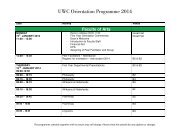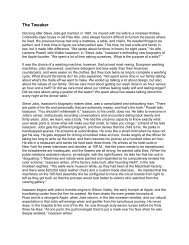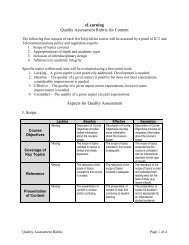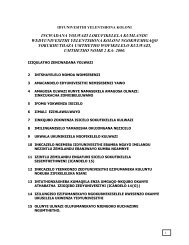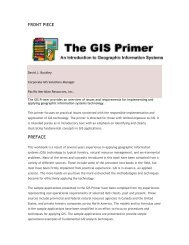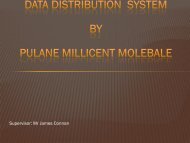Ecosystem Guidelines for Environmental Assessment
Ecosystem Guidelines for Environmental Assessment
Ecosystem Guidelines for Environmental Assessment
Create successful ePaper yourself
Turn your PDF publications into a flip-book with our unique Google optimized e-Paper software.
INCLUDING BIODIVERSITY CONSIDERATIONS IN PRE-APPLICATION PROJECT PLANNING<br />
TAKING A PRO-ACTIVE APPROACH<br />
Charl de Villiers<br />
Why take a pro-active approach<br />
Early reference to these ecosystem guidelines and to available systematic biodiversity plans (see Table 2)<br />
in the pre-application stage of project development can support in<strong>for</strong>med planning and decision-making<br />
while helping to timeously 'iron out' obstacles that might otherwise result in delays and additional<br />
costs to the project proponent. The pro-active emphasis on pre-application screening is consistent with<br />
the Western Cape Department of <strong>Environmental</strong> Affairs and Development Planning's (DEA&DP) Guideline<br />
<strong>for</strong> involving biodiversity specialists in EIA processes: Edition 1 (Brownlie 2005).<br />
Such a pro-active approach can:<br />
Show the decision-making authority that potential conflict between biodiversity priorities and other<br />
land-uses has been identified and resolved by well-in<strong>for</strong>med project planning;<br />
Allow the proponent to take an in<strong>for</strong>med decision about the biodiversity (and administrative and, by<br />
implication, financial) risks of proceeding with a particular project; and<br />
Identify the scope, type and intensity of environmental assessment that is likely to be required if an<br />
application were to proceed.<br />
This approach also supports best practice in environmental assessment and planning by:<br />
Ensuring that a project is consistent with the 'Duty of Care' principle (i.e. that the project proponent<br />
has taken reasonable measures to prevent significant degradation of the environment);<br />
Emphasising the fundamental role of alternatives in selecting the best practicable environmental<br />
option;<br />
Giving effect to the mitigation hierarchy, or the sequential avoidance, minimising and remedying of<br />
impacts that may result in loss of biodiversity or disturbance to ecosystems; and<br />
Supporting the principle that environmental management must pay specific attention to planning<br />
procedures pertaining to sensitive, vulnerable, highly dynamic or stressed ecosystems.<br />
The credibility of this approach is strictly premised on site visits as an essential component of preapplication<br />
biodiversity screening. Without ground-truthing and accurate reporting, biodiversity<br />
screening that relies solely on reference to biodiversity maps and plans must be viewed as incomplete<br />
and there<strong>for</strong>e inadequate <strong>for</strong> the purposes of in<strong>for</strong>med decision-making.<br />
<strong>Environmental</strong> assessment practitioners without the appropriate biodiversity expertise should not<br />
resort to the approach advocated here as a substitute <strong>for</strong> specialist knowledge and review. Early<br />
appointment of a knowledgeable biodiversity specialist is strongly advised, especially where projects<br />
may be undertaken in Critically Endangered, Endangered or Vulnerable ecosystems.<br />
There are several examples of pro <strong>for</strong>ma terms of reference or guidelines <strong>for</strong> dealing with biodiversity<br />
in environmental assessment and planning:<br />
The most recent is the DEA&DP's biodiversity guideline (Brownlie 2005), which should be seen as<br />
complementary to these guidelines.<br />
COLIN PATERSON-JONES<br />
14 : TAKING A PRO-ACTIVE APPROACH



